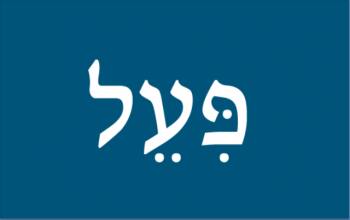Hebrew Verbs in Action: Binyan Pi’el Posted by Ayana on Aug 20, 2018 in Grammar

The Hebrew language is composed of many roots.
The verbal stems – the בּׅנְיָנׅים (plural form, pronounced as bin-ya-nim) – are the patterns that shape them into actual words. בִּנְיָן (singular form, pronounced as bin-yan), literally means building, is a firm structure into which the root is inserted to form the verb.
There are seven verbal stems in the Hebrew Language: hif’il, huf’al, nif’al, pa’al, pi’el, pu’al, it’pa’el.
בַּשָּׂפָה הָעׅבְרׅית יֵשׁ שִׁבְעָה בּׅנְיָנׅים: הִפְעִיל, הֻפְעַל, נִפְעַל, פָּעַל, פִּעֵל, פֻּעַל וְהִתְפַּעֵל.
In our last post we delved into the root א.י.ר, and its infinitive לְאַיֵּיר (means “to illustrate”). This root in Hebrew is conjugated in the verbal stem pi’el (פִּעֵל). The verbal stem פִּעֵל is one of the easiest בּׅנְיָנׅים in Hebrew. You can tell this just by looking – no prefix or suffix to its basic form. The prefixes and suffixes that will be added to the root in this בִּנְיָן will be only belong to the pronouns.
פִּעֵל is an active verbal stem. The roots in this בִּנְיָן are not passive.
Let’s check, for example, the conjugations of the root ס.פ.ר according to the tenses. The infinitive of this root is לְסַפֵּר (pronounced as le-sa-per), meaning “to tell”.
| I | He | She | You (single male) | You (single female) | They (males / males + females) | They (only females) | We | |
| Past | סׅפַּרְתּׅי | סׅפֵּר | סׅפְּרָה | סׅפַּרְתָּ | סׅפַּרְתְּ | סׅפְּרוּ | סׅפְּרוּ | סׅפַּרְנוּ |
| Present | מְסַפֵּר | מְסַפֵּר | מְסַפֶּרֶת | מְסַפֵּר | מְסַפֶּרֶת | מְסַפְּרׅים | מְסַפְּרוֺת | מְסַפְּרׅים |
| Future | אֲסַפֵּר | יְסַפֵּר | תְּסַפֵּר | תְּסַפֵּר | תְּסַפְּרׅי | יְסַפְּרוּ | תְּסַפֵּרְנָה | נְסַפֵּר |
Past tense: the first letter of the root is always dotted with םׅ (hiriq). No prefix in the past tense.
Present tense: the vowel of the first letter is םַ (patach). Only מְ as a prefix in the present tense for all the pronouns.
Future tense: the vowel of the first letter is םַ (patach). Four prefixes for the future tense: the letters אית”ן.
בִּנְיָן פִּעֵל stresses the activity of the doer. Many verbs in בִּנְיָן פִּעֵל bear the meaning of causing, making this action happening. Verbs like: לְחַזֵּק (to strengthen), לְקַצֵּר (to shorten), לְלַמֵּד (to teach), לְגַדֵּל (to bring up, to rear), לְפַתֵּחַ (to develop), לְחַנֵּךְ (to educate), לְפַטֵּר (to fire), לְקַבֵּץ (to gather). The verb לְרַכֵּז (pronounced as le-ra-kez), for instance, means “to assemble”. It conjugated as follow:
| I | He | She | You (single male) | You (single female) | They (males / males + females) | They (only females) | We | |
| Past | רִכַּזְתִּי | רִכֵּז | רִכְּזָה | רִכַּזְתָּ | רִכַּזְתְּ | רׅכְּזוּ | רׅכְּזוּ | רִכַּזְנוּ |
| Present | מְרַכֵּז | מְרַכֵּז | מְרַכֶּזֶת | מְרַכֵּז | מְרַכֶּזֶת | מְרַכְּזִים | מְרַכְּזוֺת | מְרַכְּזִים |
| Future | אֲרַכֵּז | יְרַכֵּז | תְּרַכֵּז | תְּרַכֵּז | תְּרַכֵּזִי | יְרַכְּזוּ | תְּרַכֵּזְנָה | נְרַכֵּז |
Some of the verbs in בִּנְיָן פִּעֵל bear the meaning of a continues action. Something that didn’t happen once or mildly, but for a long time or with extra intensity. For example, the infinitive לְקַפֵּץ (pronounced as le-ka-petz), means “to hop”, “to skip”. Unlike the infinitive לׅקְפוֺץ (pronounced as lik-fotz), which has the same root ק.פ.ץ, but uses another בִּנְיָן and has the meaning of “to jump”.
| I | He | She | You (single male) | You (single female) | They (males / males + females) | They (only females) | We | |
| Past | קׅפַּצְתּׅי | קׅפֵּץ | קׅפְּצָה | קׅפַּצְתָּ | קׅפַּצְתְּ | קׅפְּצוּ | קׅפְּצוּ | קׅפַּצְנוּ |
| Present | מְקַפֵּץ | מְקַפֵּץ | מְקַפֶּצֶת | מְקַפֵּץ | מְקַפֶּצֶת | מְקַפְּצׅים | מְקַפְּצוֺת | מְקַפְּצׅים |
| Future | אֲקַפֵּץ | יְקַפֵּץ | תְּקַפֵּץ | תְּקַפֵּץ | תְּקַפְּצׅי | יְקַפְּצוּ | תְּקַפֵּצְנָה | נְקַפֵּץ |
Other verbs in בִּנְיָן פִּעֵל with a continues or a powerful meaning are: לְחַזֵּר (to court), לְשַׁמֵּר (to preserve), לְקַטֵּר (to continuously complain), לְמַגֵּר (to overthrow), לְשָׁרֵשׁ (to uproot).
The punctuation of פִּעֵל is different from the examples above only when the verb’s root second letter is א or ר. In this case the second letter will not receive the diacritic dot, and its vowel םְ will be םֲ. The vowel in the first letter of the root will change as well. The vowel םׅ will become םֵ, and the vowel םַ will become םָ. As we will notice in the verb לְתָאֵר (pronounced as le-ta-er, means “to describe”).
| I | He | She | You (single male) | You (single female) | They (males / males + females) | They (only females) | We | |
| Past | תֵּאַרְתּׅי | תֵּאֵר | תֵּאֲרָה | תֵּאַרְתָּ | תֵּאַרְתְּ | תֵּאֲרוּ | תֵּאֲרוּ | תֵּאַרְנוּ |
| Present | מְתָאֵר | מְתָאֵר | מְתָאֶרֶת | מְתָאֵר | מְתָאֶרֶת | מְתָאֲרׅים | מְתָאֲרוֺת | מְתָאֲרׅים |
| Future | אֲתָאֵר | יְתָאֵר | תְּתָאֵר | תְּתָאֵר | תְּתָאֲרׅי | יְתָאֲרוּ | תְּתָאֵרְנָה | נְתָאֵר |
Try to conjugate these verbs according to the tenses: לְצַלֵּם (to film), לְאַבֵּד (to lose), לְקַשֵּׁר (to connect),לְכַבֵּד (to respect), לְקַשֵּׁט (to decorate), לְדָרֵג (to classify), לְשַׁעֵר (to imagine), לְשַׁלֵּם (to pay), לְחַשֵּׁב (to calculate), לְסַדֵּר (to organize), לְקַבֵּל (to receive). To practice their meaning use these verbs to built sentences. If you have any question leave me a comment. בְּהַצְלָחָה! (good luck!)
Keep Calm and Learn Hebrew

Build vocabulary, practice pronunciation, and more with Transparent Language Online. Available anytime, anywhere, on any device.



